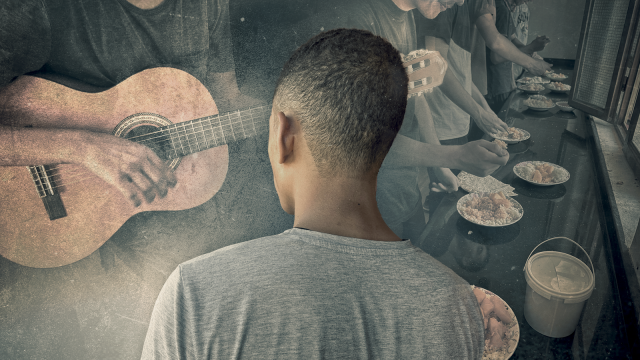A snaking line of armoured personnel carriers takes us to the epicentre of the last stand of Islamic State (IS).
The troops from the Syrian Democratic Forces (SDF) move swiftly through the Deir Azzour region in northeast Syria.
They’re often the target of attacks from IS sleeper cells they believe operate here – and which are proliferating in number and capability.
Days before I visited, the SDF’s anti-terrorism units carried out what they described as a “successful” operation to bust a three-man IS cell. Along with the suspected terrorists, they seized AK-47s, a pistol, a grenade and smartphones.
The cell, they say, was responsible for carrying out a range of attacks against troops as well as civilians in the region.
Standing guard on the hill overlooking Baghooz, where they reclaimed IS’s last sliver of territory five years ago, SDF soldiers share their fear that the extremists are planning attacks from there and beyond.
SDF commander, Siamand Ali, says it is imperative the international community keeps its mind focused on the growing resurgence of IS militants in an area they believe is more unstable than ever.
“IS stayed a long time in Deir Azzour and many sleeper cells are trying to reactivate so we need to maintain our resistance to this, along with our international partners, to ensure it doesn’t,” he says.
The area is controlled by the Kurdish-led SDF forces but in this oil-rich region, there are also US bases and other international forces as part of the global coalition which was set up to fight IS a decade ago.
‘We are fighting the war of the militias’
The area is separated by the Euphrates River with Iran-supported regime forces loyal to the Syrian leader Bashar al Assad on the opposite side of the river’s banks. Iraqi militia also operates in this geographical confluence.
“We are fighting the war of the militias,” the SDF commander tells me.
With Israel bordering the south of Syria, and Lebanon on its western border, the area is surrounded by militias forming part of what is known as the Axis of Resistance, with fighters from Iraq, Syria, Yemen and Lebanon all with their guns pointed at both Israel and Israel’s partners over the war in Gaza.
“The attacks are distracting from our fight against IS,” Commander Ali says.
Rare access to prison housing IS men
The mainly Kurdish authorities in northeast Syria are in charge of securing the pop-up prisons and detention centres housing tens of thousands of IS fighters and their families captured during the five year-long battle.
I was given rare access to a prison housing thousands of “Daesh” or IS men, and instructed not to reveal its location or name. IS has staged several raids in the past to try and free the detainees.
Human rights groups have also criticised the lack of transparency over the judicial process involved. I was told not to interact with the prisoners, but several men in the same cell catch our attention.
One tells me there are 64 men in their small cell. “We are all Daesh,” he says.
Another tells me in broken English how he’s been held here since he was 17 years old. He asks: “Can you help me get home?”
Many of those captured by the coalition forces when they were fighting IS were underage.
Some young men, whose fathers were accused of being IS fighters, were taken to juvenile confinement centres where the Kurdish authorities are putting them through a deradicalisation programme.
‘I was just a child. I had no choice’
The centre I visit is heavily guarded with barbed wire around the perimeter. Some of its inhabitants have been held for lengthy periods, such as a young man who tells me he’s been at the centre for nearly five years.
He says he’s from Trinidad and was taken to IS territory in Syria by his parents when he was 10. His mother had just married his stepfather and neither of them were aware of where they were going.
“I was just a child,” he says. “I had no choice.”
He was separated from his mother several times during their stay in Syria. He says he spent a month in an IS jail but insists he was never radicalised.
“I’m not IS. I never went to a training camp or anything,” he says, with obvious frustration.
“No one is asking if we’ve changed,” he goes on. “I don’t know what they’re calling us – cubs of the caliphate and stuff like that – but no one is coming by to see, have they changed, who is being good, who is not. They’re just putting everyone in one category and saying these are just kids from IS and that’s it.”
Mother says she ‘regretted every single step of it’
His mother is being held in Al Roj, in one of two large, tented detention camps housing the IS families of mainly women and children. When I track her down, she is full of regret for taking her son to Syria and says she was duped by the man she married.
“I had no idea we were going to Syria and as soon as we got there I wanted to leave,” she says.
She says she divorced him within days, and she and her young son were left to fend for themselves. They moved around and slept on the floor of mosques until the other women said her son couldn’t stay in the female-only quarters with her.
“I regretted every single step of it,” she says. “I hated seeing dead people hanging up on the side of streets. I hated the fact that my son witnessed this.
“I hate the fact of so many bad things, okay? This man being burnt in a cage… people being drowned in a sewer. This was horrific.”
The two of them feel trapped, with Kurdish authorities continually saying they have neither the resources nor the desire to cope with the tens of thousands under their guard who were swept up in the aftermath of the fall of IS.
They want the 80-plus countries who took part in the global fight against IS and whose citizens travelled to join the IS caliphate to take responsibility for their countrymen and women and repatriate them.

























